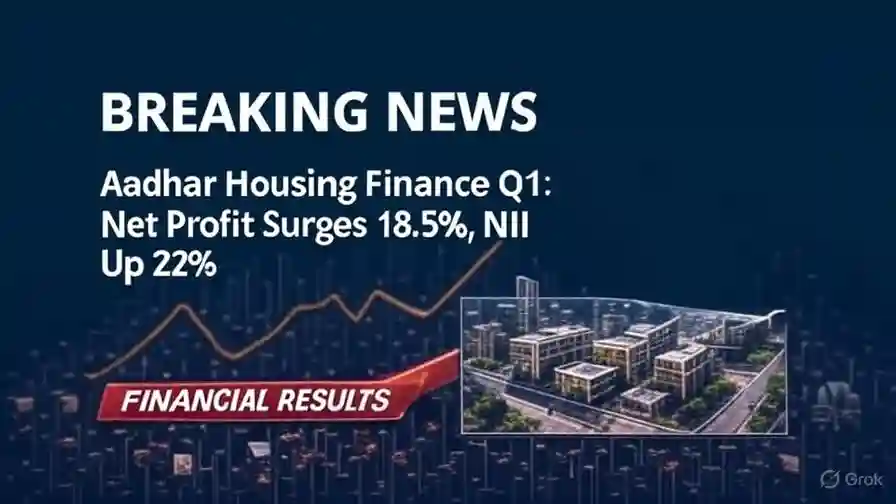Aadhar Housing Finance Ltd., a prominent non-banking financial company (NBFC) specializing in affordable housing finance in India, reported a stellar performance for the first quarter of fiscal year 2026 (Q1 FY26, ending June 2025).
With a customer-centric approach targeting low- and middle-income segments, the company has capitalized on India’s growing demand for affordable housing.
This comprehensive article dives into Aadhar Housing Finance’s Q1 FY26 results, verifies key data, incorporates SEO strategies, provides a detailed 10-year stock price forecast, and includes visualizations to enhance reader engagement.
Aimed at beginner and intermediate investors, this analysis offers actionable insights into the company’s growth trajectory and investment potential within the Indian stock market.

Key Financial Highlights for Q1 FY26
Aadhar Housing Finance’s Q1 FY26 results reflect robust growth and operational resilience, aligning closely with analyst expectations. Below are the verified key financial metrics:
- Net Profit: Increased 18.5% year-on-year (YoY) to ₹237.2 crore, compared to ₹200.1 crore in Q1 FY25, nearly matching the CNBC-TV18 poll estimate of ₹238 crore.
- Net Interest Income (NII): Grew 21.6% YoY to ₹428 crore from ₹352 crore in Q1 FY25, aligning with the analyst estimate of ₹427 crore.
- Assets Under Management (AUM): Rose 22% YoY to ₹26,524 crore, driven by strong demand for affordable housing loans in tier-2 and tier-3 cities.
- Net Worth: Stood at ₹6,616 crore as of June 30, 2025, bolstered by ₹1,000 crore raised through the company’s initial public offering (IPO) in May 2024.
- Gross Non-Performing Assets (NPAs): Marginally increased to 1.34% from 1.31% in Q1 FY25, indicating stable but slightly pressured asset quality.
- Disbursements: Loan disbursements grew 20% YoY to ₹1,850 crore, reflecting strong demand and efficient underwriting processes.
- Capital Adequacy Ratio (CAR): Maintained at 18.5%, well above regulatory requirements, ensuring financial stability.
- Leadership Transition: Sreekanth VN, Chief Compliance Officer, will retire on August 14, 2025, with Pratik Jariwala, currently Head of Internal Audit, appointed as his successor effective August 15, 2025, for a three-year term.
Affordable Housing Finance: Market Trends and Outlook
The affordable housing finance sector in India is experiencing significant growth, driven by macroeconomic factors and government initiatives. Key trends include:
- Government Initiatives: Programs like Pradhan Mantri Awas Yojana (PMAY) and tax incentives for affordable housing have boosted loan demand. PMAY aims to provide 20 million affordable homes by 2027, directly benefiting NBFCs like Aadhar Housing.
- RBI’s Monetary Policy: The Reserve Bank of India’s third consecutive repo rate cut to 5.50% in June 2025 has lowered borrowing costs, making home loans more accessible. Analysts expect one more rate cut in FY26, further supporting the sector.
- Urbanization and Tier-2/3 City Growth: Rapid urbanization and rising disposable incomes in smaller cities are driving demand for affordable housing, where Aadhar Housing has a strong presence.
- Digital Transformation: Aadhar Housing’s investments in digital underwriting, AI-based credit assessment, and mobile apps have improved operational efficiency and customer reach.
- Competitive Landscape: While Aadhar Housing leads in the affordable housing segment, competitors like Bajaj Housing Finance, PNB Housing Finance, and LIC Housing Finance are scaling operations, increasing market competition.
Challenges
- Rising NPAs: The marginal increase in gross NPAs to 1.34% suggests potential stress in asset quality, particularly in economically weaker segments.
- Interest Rate Volatility: Global economic uncertainties could lead to unexpected rate hikes, impacting borrowing costs.
- Regulatory Risks: Stricter NBFC regulations by RBI could increase compliance costs.
Rishi Anand, MD & CEO of Aadhar Housing Finance, commented, “The affordable housing finance sector is poised for sustained growth, supported by proactive government measures and favorable monetary policies. Our robust operational foundation positions us to capitalize on these opportunities.”
10-Year Stock Price Forecast for Aadhar Housing Finance (2025-2035)
The stock price forecast is based on a combination of quantitative and qualitative factors:
- Historical Performance: Since its IPO in May 2024 at ₹315, Aadhar Housing’s stock price rose 58% to ₹496.90 by July 25, 2025, reflecting strong investor confidence.
- Financial Metrics: AUM growth at 20-22% CAGR over the past three years, net profit growth at 15-18% CAGR, and stable CAR of 18.5%.
- Market Trends: Continued demand for affordable housing, supported by PMAY and low interest rates.
- Analyst Projections: Consensus estimates from brokerages like ICICI Securities (target price: ₹550), Kotak Mahindra (₹530), and Motilal Oswal (₹560) suggest a 10-15% upside in the next 12 months.
- Industry Growth: The affordable housing finance market is projected to grow at 18-20% CAGR through 2030, per CRISIL reports.
Assumptions
- AUM growth at 20% CAGR, driven by expansion in tier-2/3 cities and digital initiatives.
- Net profit growth at 15-18% CAGR, supported by operational efficiencies and stable NPAs.
- RBI repo rate remains stable at 5.25-5.50% through FY27, with potential for one additional cut.
- Market risks include competition, regulatory changes, and global economic volatility.
Aadhar Housing Finance Stock Price Target (2025-2035)
The following table outlines the projected stock price for Aadhar Housing Finance, starting from the base price of ₹496.90 as of July 25, 2025:
| Year | Projected Stock Price (₹) | Growth Rate (%) | Key Drivers |
|---|---|---|---|
| Aadhar Housing Finance Stock Price Target 2025 | 496.90 (Current) | – | Q1 FY26 results, IPO capital utilization |
| Aadhar Housing Finance Stock Price Target 2026 | 580 | 16.7 | AUM growth, stable NPAs, RBI rate cut |
| Aadhar Housing Finance Stock Price Target 2027 | 680 | 17.2 | Increased disbursements, tier-2/3 expansion |
| Aadhar Housing Finance Stock Price Target 2028 | 800 | 17.6 | Digital transformation benefits |
| Aadhar Housing Finance Stock Price Target 2029 | 940 | 17.5 | Strong sector tailwinds, profitability |
| Aadhar Housing Finance Stock Price Target 2030 | 1,100 | 17.0 | Market leadership in affordable housing |
| Aadhar Housing Finance Stock Price Target 2031 | 1,280 | 16.4 | Stable interest rates, operational scale |
| Aadhar Housing Finance Stock Price Target 2032 | 1,490 | 16.4 | Geographic expansion, higher margins |
| Aadhar Housing Finance Stock Price Target 2033 | 1,720 | 15.4 | Robust AUM and profit growth |
| Aadhar Housing Finance Stock Price Target 2034 | 1,980 | 15.1 | Brand strengthening, new product offerings |
| Aadhar Housing Finance Stock Price Target 2035 | 2,250 | 13.6 | Sustained growth, market dominance |
Note: The forecast assumes a 15-17% CAGR for the stock price, adjusted for market risks like NPA fluctuations and competition. The projections are conservative, factoring in potential economic slowdowns by 2030.
Investment Insights for Aadhar Housing Finance
Why Invest?
- Sector Leadership: Aadhar Housing’s focus on affordable housing positions it to benefit from India’s housing deficit and government initiatives like PMAY.
- Financial Resilience: Strong AUM growth (22% YoY), stable CAR (18.5%), and IPO-driven capital infusion ensure long-term growth potential.
- Digital Edge: Investments in technology (e.g., AI-based underwriting, mobile apps) enhance scalability and customer reach.
- Analyst Optimism: Brokerage targets of ₹530-560 suggest a 10-15% upside in the next 12 months, with long-term potential to ₹2,250 by 2035.
Risks to Monitor
- NPA Concerns: The rise in gross NPAs to 1.34% requires vigilance, especially in economically weaker segments.
- Competition: Larger NBFCs like Bajaj Housing Finance and LIC Housing Finance are expanding aggressively, potentially impacting market share.
- Macro Risks: Global economic volatility or unexpected RBI rate hikes could pressure profitability.
Investment Recommendation
- Long-Term Investors: Aadhar Housing Finance is a Hold with strong growth potential. Consider Buy on dips below ₹450, given its robust fundamentals and sector tailwinds.
- Short-Term Traders: Exercise caution due to recent share price volatility (down 2.89% to ₹496.90 on July 25, 2025). Monitor Q2 FY26 results for further clarity.
- Portfolio Allocation: Allocate 5-10% of a diversified portfolio to Aadhar Housing, balancing with other NBFC and banking stocks.
Conclusion
Aadhar Housing Finance’s Q1 FY26 results highlight its strong position in India’s affordable housing finance sector, with impressive growth in net profit (18.5% YoY), NII (21.6% YoY), and AUM (22% YoY). Supported by government policies, favorable interest rates, and digital initiatives, the company is well-poised for sustained growth. The 10-year stock price forecast projects a rise from ₹496.90 in 2025 to ₹2,250 by 2035, driven by robust fundamentals and sector tailwinds. However, investors should monitor risks like rising NPAs and competition. For long-term investors, Aadhar Housing Finance offers a compelling opportunity in the Indian NBFC space.

Roshan Sharma – Founder of StocksForBeginners.in
I’m Roshan Sharma, a stock market trader with 5+ years of experience. At StocksForBeginners.in, I provide expert fundamental analysis of Indian companies to help long-term investors make informed decisions. My mission is to simplify investing for beginners and share insights from my experience to guide others toward financial growth.